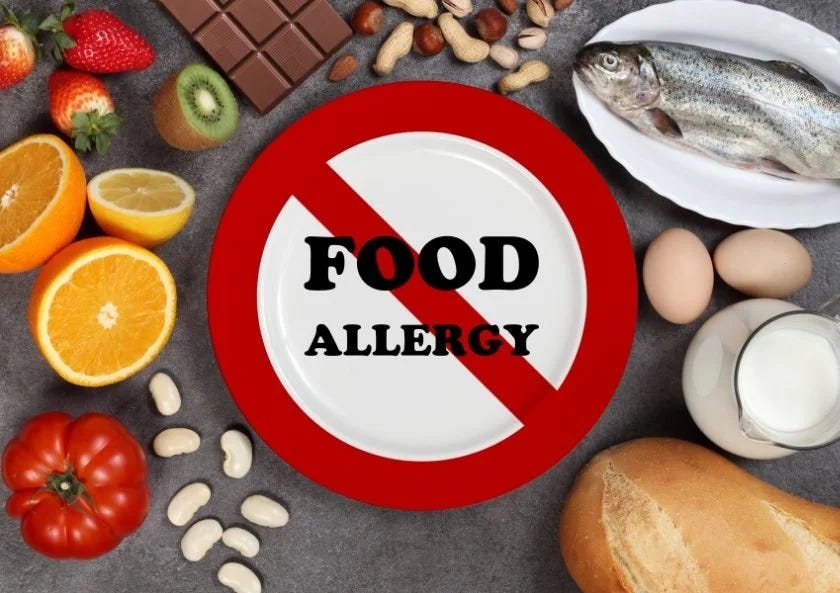Could Your Favorite Foods Be Making You Sick... Days Later?
Understanding Delayed Food Allergies – The Symptoms, Testing, and My Own Experience.
Have you ever eaten something and felt fine at first, only to feel bloated, exhausted, or just “off” hours or even days later? You might blame stress, lack of sleep, or just a random stomachache—but what if the real culprit is something you ate? This could be due to a delayed-type food allergy, a reaction that takes time to appear but can still impact your health.
A quick personal story— Until I was 18, I drank milk with cereal every day, easily finishing two bottles a week (that’s 4 liters!). Then, out of nowhere, I started experiencing intense stomach pain every few hours I had milk. I had been fine my whole life, so I was confused—why was this happening?
Frustrated, I decided to get tested. That’s when I discovered I had a delayed-type food allergy to milk.
Unlike immediate food allergies, which trigger reactions right away, delayed allergies can take hours or even days to show up, making them much harder to pinpoint.
As a 6th-year medical student who just submitted my MD thesis on food allergies, I want to break this down in a way that’s easy to understand. If you’ve ever felt unwell after eating but couldn’t figure out why, this might be the missing piece of the puzzle!
What Are Delayed-Type Food Allergies?
Most people are familiar with immediate food allergies, like those to peanuts or shellfish, which cause rapid and sometimes life-threatening reactions. However, delayed-type food allergies work differently—they don’t cause an instant reaction. Instead, symptoms can take hours to days to appear, making it difficult to pinpoint which food is responsible.
Your immune system plays a key role in these allergies. When you consume a triggering food, your body mistakenly sees it as a threat and launches an immune response. Unlike immediate allergies, which involve antibodies that cause rapid symptoms, delayed-type allergies involve a slower immune response that leads to inflammation over time. This can manifest in various ways, from digestive issues to chronic fatigue.
Due to the delayed onset of symptoms, individuals often do not realize the connection between their symptoms and specific foods. They may attribute their discomfort to normal bloating, fatigue, or skin issues, without recognizing that their diet could be the underlying cause. A delayed food allergy can take between 2 and 24 hours to show symptoms.
How Does a Delayed Reaction Work?
Sensitization When the body first encounters a food allergen, there might not be an immediate reaction, but the immune system recognizes and remembers the allergen.
Re-exposure Upon subsequent consumption of the same food, the immune system identifies it as a threat, initiating an inflammatory response.
Symptoms Appear Symptoms can take hours to days (typically 48-72 hours) to manifest, making it difficult to directly link them to the ingested food.
If a reaction occurs every time a food is eaten it is more likely to be a true food allergy. Because of the time delay between eating the food and having symptoms it is much more difficult to pinpoint whether the food causes an allergy every time it is eaten. For this reason a food diary is recommended.
Symptoms to Watch For 👀
Symptoms of delayed-type food allergies can be subtle and vary from person to person, but common ones include:
✅ Skin reactions – Rashes, eczema, or hives
✅ Digestive issues – Abdominal pain, bloating, diarrhea, or nausea
✅ Respiratory problems – Nasal congestion or asthma-like symptoms
✅ Systemic symptoms – Fatigue, headaches, or joint pain
These symptoms are often mistaken for stress, poor diet, or other medical conditions, making delayed-type food allergies tricky to diagnose.
Common Food Triggers 🍞🥛🥜
While any food can potentially cause a delayed reaction, the most common culprits include:
🥛 Dairy products – Milk, cheese, yogurt
🌾 Gluten grains – Wheat and other gluten-containing foods
🥚 Eggs – Both egg whites and yolks
🌱 Soy products – Tofu, soy milk, and other soy-based foods
🥜 Nuts and seeds – Almonds, walnuts, sunflower seeds, etc.
How to Identify Delayed-Type Food Allergies 🔍
Because symptoms don’t appear right away, special methods are needed to pinpoint food triggers:
Food Diary – Keeping a detailed food diary is one of the most effective ways to identify potential food triggers. Record everything you eat, along with any symptoms experienced afterward. This practice helps establish patterns and correlations between specific foods and delayed reactions. Over time, this information can provide valuable insights into which foods may be causing issues
⏳ Elimination Diet – This method involves temporarily removing suspected foods from your diet for a period of time (usually 2-6 weeks). After this period, reintroduce these foods one at a time while monitoring for any return of symptoms. This systematic approach helps clarify whether specific foods are responsible for allergic reactions.
🩺 Medical Consultation – An allergist or immunologist can help assess your symptoms and recommend tests.
Managing Delayed-Type Food Allergies 🛡️
Once you identify your food triggers, the best way to manage symptoms is to avoid those foods. Here are some practical tips:
✔ Read Food Labels – Learn to recognize hidden allergens in packaged foods.
✔ Plan Meals Ahead – Cooking at home gives you better control over ingredients.
✔ Communicate Your Needs – Let friends, family, and restaurants know about your allergies to prevent accidental exposure.
✔ Consider Professional Support – Regular check-ups with a healthcare provider can help you stay on track.
Exploring Testing Options 🏥
🛍️ At-Home Test Kits – While not 100% accurate, at-home test kits can be a helpful way to start identifying potential triggers. I personally took an at-home food allergy test, and although it was a bit expensive, it gave me valuable insights into my food sensitivities. If you’re curious, it might be worth trying—but keep in mind that professional guidance is still important!
🇯🇵 Ningen Dock in Japan – If you ever plan on visiting Japan, you might want to consider taking the Ningen Dock, a comprehensive health check-up service. Some facilities offer delayed-type allergy testing, which could be an excellent opportunity to get a deeper look into your health. If you’re interested in learning more about Ningen Dock, please check out my previous newsletter or visit our website for details!
Final Thoughts 💡
When I first got my test results back, I was shocked to see that I wasn’t just allergic to milk, but also to oranges and yogurt… I never suspected those foods could be affecting me. However, it was good to know about it. I try to avoid these foods as much as possible, but since delayed-type allergies aren’t as severe as immediate allergies, I sometimes still eat them in small amounts.
Understanding delayed-type food allergies has helped me make better choices and feel healthier overall. If you suspect you have one, start tracking your symptoms and consult a healthcare provider for guidance. Small changes to your diet can lead to big improvements in how you feel!






Good that you write about this, Miki.
I have Coeliac Disease — not an allergy but an autoimmune disease — but it can also have delayed symptoms. Some of them quite serious and affecting me for years.
Few people in Japan have Coeliac Disease and most doctors here are totally unfamiliar with it. As far as I know there is no doctor in Japan specializing in it.
When I was finally diagnosed in 2009 Coeliac Disease tests were not even available in Japan. That probably is still the case today. Actually, I occasionally still get a blank stare when I tell a doctor I have Coeliac Disease.
As a result, it took several decades before I was finally diagnosed correctly.
Until then, doctors told me I suffered from stress, a dislocated disk in my neck, or came up with other imaginative and unimaginative explanations to explain my constant exhaustion, migraines, and other health issues.
I believe I still have one more undiagnosed health issue. It might be a good idea to look into delayed allergies. Any idea how and where in Japan one gets tested for these?
This is similar to EoE but it's not an allergy and can take a years before the esophagus has constricted enough to feel the effects. An absolutely awful disease but I finally oveercome it through a modified diet and omeprazole.